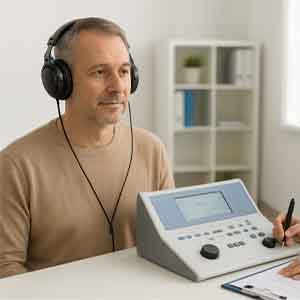Audiometry before hearing aid fitting
Why Audiometry Is Needed Before Choosing a Hearing Aid
Hearing audiometry is a key step before selecting a hearing aid. Without accurate hearing measurement, it is impossible to determine the degree of hearing loss and, consequently, the optimal type of device. Many people mistakenly believe that a hearing aid can be chosen by sight or based on friends’ recommendations, but this often leads to discomfort and reduced effectiveness of use.
Hearing tests help detect even minimal impairments that a person may not notice. Hearing aid diagnostics start with audiometry, as it allows specialists to determine precisely the frequency ranges where problems occur. This is especially important for elderly patients and people with gradual hearing loss.
Audiometry is necessary not only for selecting a device but also for subsequent adjustment of the hearing aid. The results of the hearing test allow a specialist to customize the device according to the individual needs of the patient. This increases comfort and the effectiveness of use.
Moreover, audiometry can identify hidden pathologies of the hearing system. Even in cases of mild impairments, specialists can provide recommendations for prevention and improvement of hearing, which later facilitates adaptation to the hearing aid.
How the Audiometry Procedure Works and What It Shows
The audiometry procedure is usually conducted in a specialized room using modern equipment. The patient wears headphones and listens to a series of sounds of different frequencies and volumes, responding in a specific way. This test measures sensitivity to various sounds and allows an audiogram to be created.
An audiogram reflects the level of hearing at each frequency and serves as the basis for selecting a hearing aid. Based on the results, the specialist can determine which type of device and what settings will be optimal for the specific patient.
Advantages of Audiometry for Hearing Aid Selection
-
Accurate hearing diagnostics across different frequencies
-
Individualized hearing aid adjustment
-
Detection of hidden hearing problems
-
Ability to adapt to specific living conditions
-
Recommendations for prevention and hearing improvement
After the hearing test, the specialist explains the results to the patient and recommends the most suitable device options. Hearing adjustment is carried out taking all identified features into account, allowing the patient to quickly get used to the device.
Hearing testing also helps determine the need for additional device features, such as noise reduction or high-frequency amplification. This is important for comfortable speech perception in noisy environments and outdoors.
The patient receives detailed recommendations for further adaptation of the hearing aid, and the company Center of Hearing provides professional support at all stages — from diagnostics to adjustment and follow-up.
Specialists’ Recommendations After Hearing Testing
After audiometry, specialists provide individual advice on using and adapting the hearing aid. They explain how to properly wear the device and gradually increase usage time for comfortable adaptation.
It is important to follow the recommendations regarding hearing adjustment to ensure the hearing aid works as effectively as possible. Specialists advise regularly undergoing hearing checks and adjusting the device settings as needed.
After the procedure, specialists can also provide recommendations for preventing further hearing loss. This includes using protection against loud sounds, monitoring overall health, and regular hearing measurements.
Finally, patients receive detailed instructions for the care and use of the hearing aid. Proper adaptation reduces discomfort and ensures long-term device service, while Center of Hearing offers support and consultation at every stage of use.

















